Biodiversity Monitoring Indicators in Protected Areas: A Study from Ratapani Wildlife Sanctuary, Madhya Pradesh, India
13.11.2024
SUBMITTING ORGANIZATION
Integrated Development Organisation
OTHER CONTRIBUTING ORGANIZATIONS
Symbiosis International (Deemed University)
DATE OF SUBMISSION
October 2024
REGION
Asia
COUNTRY
India
KEYWORDS
Biodiversity indicators, indicators for management, managed forests, biodiversity functions, forest conservation
AUTHORS
https://orcid.org/0009-0000-1231-7484
Former MD & Country Head, Green Highways Mission, Ministry of Road Transport & Highways, India
Former Founder CEO, Madhya Pradesh Ecotourism Development Board, Bhopal, India
Symbiosis Institute of International Business,
Symbiosis International (Deemed University), Pune
Email Id: ravi.sharma@siib.ac.in
Orcid Id: 0000-0003-0819-4340
Summary Sheet
The summary sheet for this case study is available here.
Summary
The study addresses the imperative of identifying indicators for assessing biodiversity in the context of managing forests sustainably. Despite extensive research, selecting suitable indicators remains challenging. A formalized monitoring system based on identified and updated indicators is essential to inform management decisions effectively and support adaptive management by enabling complex biodiversity information to stakeholders, requiring indicators developed in response to identified needs with a risk assessment approach. Observations from the Delawari Range of Ratapani Wildlife Sanctuary highlight existing pressures on biodiversity, such as tourism, forest fires, and infrastructure development. Effective management strategies to include controlled tourism activities, mitigate potential negative impacts and communicate complex biodiversity information to diverse stakeholders by translating scientific data into actionable insights indicators facilitate stakeholder engagement and support collaborative conservation initiatives. Identified pressures, including tourism, forest fires, infrastructure development, and noise generation, are crucial management considerations. Additionally, understanding the ecological functions of biodiversity surrogates underscores their importance in assessing biodiversity.
Interpreting biodiversity indicators and management practices involves continuous monitoring of potential impacts, infrastructure development for mitigation, and introducing ecotourism concepts to enhance conservation efforts. In conclusion, while challenges persist in identifying indicators and assessing biodiversity, this study provides valuable insights into managing forests sustainably. Future research should identify feasible indicators and address limitations to enhance biodiversity assessment for sustainable forest management.
Backdrop
The conversation surrounding biodiversity and sustainable forest management has evolved into a focal point of forest policy and management. Researchers, practitioners, and forest managers increasingly recognize the intricacies involved in identifying biodiversity indicators, particularly the imperative to manage forests sustainably and sustainably. As a result, identifying biodiversity indicators has emerged as a research priority (Noss, 1990; Ferris and Humphrey, 1999). The challenge facing conservation managers lies in determining which aspects of biodiversity to assess, how to measure them accurately, and how to interpret complex ecological data to effectively inform policy and management decisions. Central to this endeavor is the concept of indicators, which serve as proxies for aspects of biodiversity that are not directly measurable but are of significant interest. Biodiversity monitoring aims to improve the condition of biodiversity at risk, serving as an outcome-based activity (Hunt et al., 2006). Indicators, defined as environmental measurements intended to signify unmeasured yet significant aspects of the environment (Suter, 2001), play a crucial role. When scientifically credible, these indicators serve as measurements of biodiversity surrogates (Sakar and Margules, 2002), estimating true biodiversity through environmental or disturbance attributes. However, selecting appropriate indicators poses a considerable challenge, and research in this area has been extensive. Despite considerable research devoted to producing sets of indicators (Smyth et al., 2003; James, 2004; Hunt et al., 2006), challenges persist in selecting realistic and credible indicators for biodiversity monitoring (Ferris and Humphrey, 1999).
Additionally, using multiple indicators simultaneously can pose limitations. Nonetheless, a formalized system for measuring and monitoring the effects of operations on biodiversity would greatly benefit stakeholders. Such a system would facilitate identifying the key indicators for monitoring and assessing managed forests, enhancing management decisions, providing benchmarks for future conditions and alternative management scenarios, and addressing challenges in biodiversity assessment for sustainable forest management.
Indicators must be developed to ensure effectiveness in response to identified needs, with a risk assessment approach central to their development. This approach should focus on predicted significant impacts rather than potential impacts, thereby enhancing the utility and relevance of the monitoring process. The key practical implication potential of such an approach will result in a better understanding of stakeholders in understanding and identifying key biodiversity indicators for monitoring and assessing managed forests, enhancing management decisions by assessing biodiversity components and measures, providing benchmarks for future conditions and alternative management scenarios; and addressing challenges in biodiversity assessment for sustainable forest management. The Ratapani sanctuary is home to endangered species, indicating the importance of conservation efforts. The diverse wildlife, including mammals, reptiles, birds, fishes, and insects, further emphasizes the Sanctuary’s ecological significance.
Socioeconomic and environmental characteristics of the area
The Delawari forest range is part of the Ratapani Wildlife Sanctuary in the Raisen District of Madhya Pradesh, India. With its rich biodiversity and scenic landscape, the Delawari forest range plays a vital role in conserving wildlife and ecological processes in the region. The Sanctuary has teak forests (55% of the area), seasonal streams, and diverse wildlife like tigers and leopards. Conservation efforts focus on protecting habitat, curbing threats, and balancing local needs.
Challenges
The challenge facing conservation managers lies in determining which aspects of biodiversity to assess, how to measure them accurately, and how to interpret complex ecological data to effectively inform policy and management decisions.
Solutions
Indicators must be developed to ensure effectiveness in response to identified needs, with a risk assessment approach central to their development. This approach should focus on predicted significant impacts rather than potential impacts, thereby enhancing the utility and relevance of the monitoring process.
- The key surrogates identified and analyzed will result in the desired outcomes as below:
- Vegetation composition typical to the Delawari range of Ratapani Wildlife Sanctuary.
- Current vegetation and wildlife status of the Sanctuary.
- Issues to discuss: the maintenance and increase of the existing native species population, ecological values, and sustainable use of resources for the stakeholders. The usefulness of selected biotic parameters as surrogate measures of different aspects of biodiversity in managed forests.
- Identify pressure elements and sustainable management concerning the stakeholders.
Approaches for Identification of Outcome-based Indicators
The study adopted a blended approach using structural indicators (physiognomy and associated indicators) and compositional indicators (indicator species, etc). Such combinations are deemed appropriate for presenting the current scenario of the region and, therefore, necessary for managing forests. From the outcomes, key biodiversity surrogates were identified and further used to assess the ecological functions of those surrogates (via panel discussion and expert opinion). In addition, the field-based indicators were identified using field surveys, sampling techniques, and biotic survey forms (visual assessment forms)—these aid in assessing the condition of biodiversity. The group discussion approach with the experts/ stakeholders and field data collection for noise level determination were deployed to identify significant components and the existing status of the condition of biodiversity and understand the impacts.
Observations
The observations collectively highlight the diverse biodiversity, existing pressures, and management efforts within the Delawari Range of the Sanctuary, emphasizing the need for sustainable management practices to preserve its ecological integrity and biodiversity values.
- Delawari Range has rich natural ecological attributes and significant biodiversity values, including diverse plant and animal species.
- Despite external pressures and disturbances, such as tourism and recreational activities, the Range maintains its natural supporting attributes and connectivity with local resources and stakeholders.
- Identified pressures on the Range, including tourism, forest fires, infrastructure development, and noise generation, pose significant threats to biodiversity and ecosystem functioning that must be managed.
- The most common tree species in the area include Terminalia tomentosa, Tectona grandis, Diospyros melanoxylon, Lannea grandis, and Chloroxylon swietenia.
- The controlled site of Delawari Range exhibits higher Shannon’s diversity and evenness compared to the uncontrolled site, indicating better ecosystem health and stability.
- The wildlife sanctuary within the Range hosts a diverse array of wildlife, including carnivores, herbivores, smaller mammals, reptiles, and over 150 species of birds.
- Population statistics of key wildlife species, such as tigers, panthers, bears, and various ungulates, show fluctuations over the years, likely influenced by human activities.
- Domestic killings of animals, such as cattle, pose a significant issue within the wildlife sanctuary, indicating potential conflicts between wildlife and local communities.
- Noise level monitoring indicates currently low levels of noise generation in the area due to controlled tourism activities, which minimizes potential negative impacts on wildlife and visitor experiences.
- Graphical representation of noise level data illustrates the absence of significant noise disturbances, suggesting effective management strategies in place.
Identified Pressures and Concerns: Key Management Considerations
Experts-based and stakeholder analysis data reveals important pressure indicators and management professionals’ concerns.
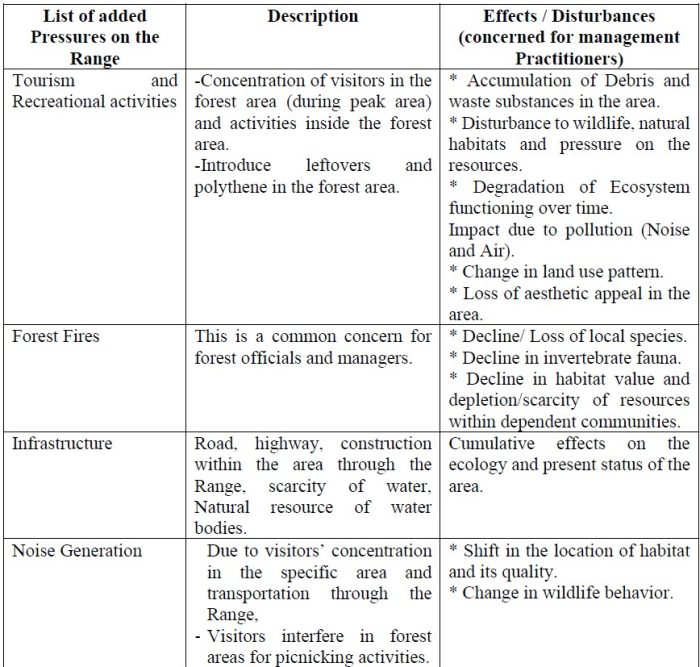
Ecological functions of the Biodiversity Surrogates
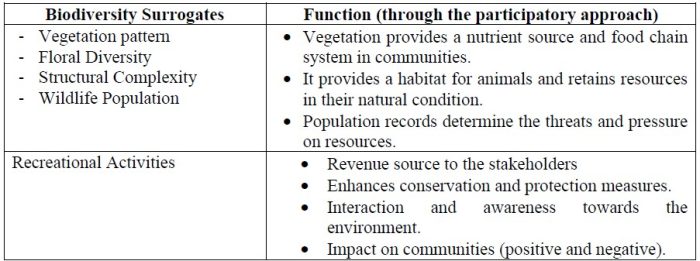
Interpreting Biodiversity Indicators and Management Practices
- It is crucial to monitor and continuously register potential impacts and threats impacting the conservation of the managed forests.
- Development of the infrastructure to mitigate threats.
- The concept of “Ecotourism” in the recreation areas of the managed forest area will be introduced, with the main focus on conservation and awareness. Community-based ecotourism has the potential to contribute to the conservation of the area and develop livelihood resilience among communities.
- Record and survey vegetation and faunal patterns over time to identify the status of regionally significant terrestrial ecological species, change in abundance, and presence or absence of non-native/invasive species. This will help in adaptive management and effectively communicate the impacts to the decision-makers.
- Identification of new potential indicators of assessment specific to the area that are capable of measuring the threshold level of disturbance, thus determining which can permit the extraction of resources without significant loss to the biodiversity of the region. Tourism carrying capacity studies can help manage recreational activities and the overall impact of tourism in the region.
Conclusion
In conclusion, formulating the problem and its framework is also required to identify potential indicators in assessing biodiversity. Though not complete, these indicators’ value in terms of covering the complexity of biodiversity and their prediction of relationship between driving forces, status, impact and mitigation measures required are necessary if further data may be available in this context. The remote data, climatic changes and the other factors, no doubt, having a combined impact on the persistence of biodiversity has not been considered here as an indicator because of the threats and pressures required management actions beyond the region’s capacity and therefore remains a limitation. In addition, new feasible indicators with a knowledge domain of the biodiversity assessment are to be identified.
Annexures
Table 1: List of major tree species encountered in vegetation survey through resource inventory method in Delawari Range. (Herbs are not taken into consideration):
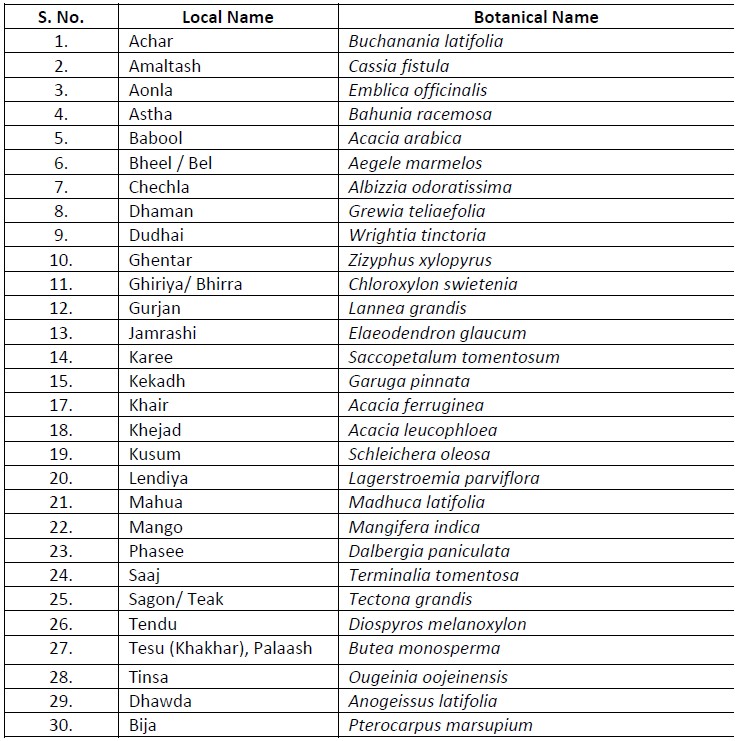
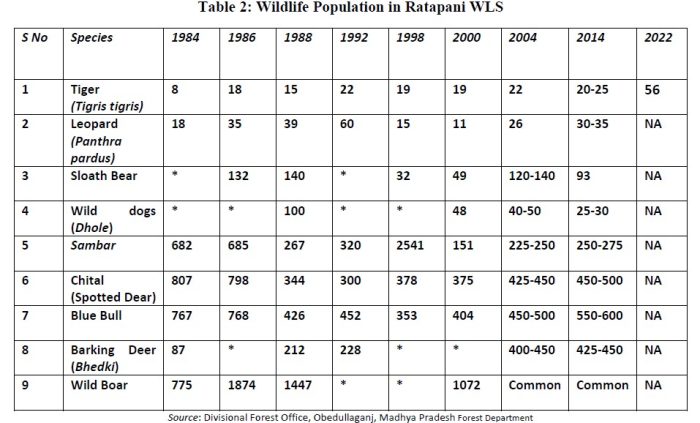
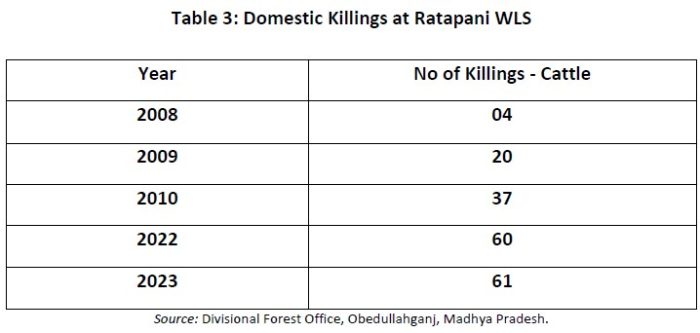

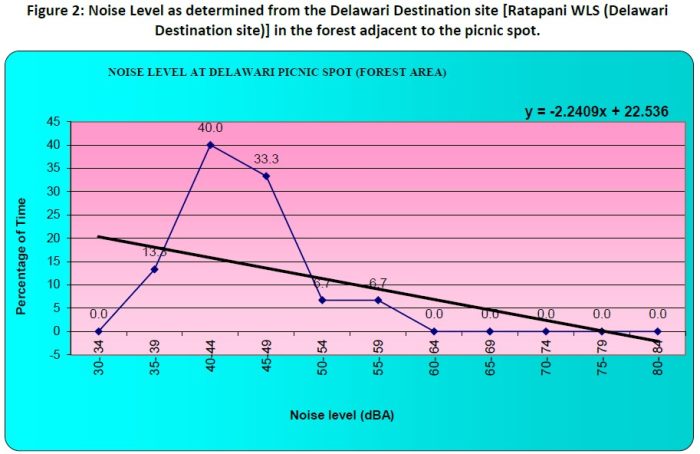
References
Noss R.F., Indicators for monitoring biodiversity: a hierarchical approach, Conservation Biology, 4, 355- 364 (1990).
Dwivedi, A. P., Protected Areas of Madhya Pradesh. Forest Department of Madhya Pradesh, Bhopal. (2003)
Ferris R. and Humphrey J.W., A review of potential biodiversity indicators for application in British forests, Forestry, 72(4), (1999).
Hunt L., Fisher A., Kutt A. and Mazzer T., Biodiversity monitoring in the rangelands: A way forward, Vol. 1, report to Environment Australia, CSIRO Sustainable Ecosystems, Alice Springs (2006).
Suter G.W., Applicability of indicator monitoring to ecological risk assessment, Ecological Indicators, 1, 101– 112 (2001).
Sakar S. and Margules C., Operationalising biodiversity for conservation planning, Bioscience, 27, 229–308 (2002).
Smyth A., James C. and Whiteman G., Biodiversity monitoring in the rangelands: A way forward, Vol. 1, report to Environment Australia, CSIRO Sustainable Ecosystems, Alice Springs (2003).
James C.D., Biodiversity monitoring in rangelands. In: Conference papers, Australian Rangeland Society 13th Biennial Conference. (Eds Bastin G, Walsh D and Nicolson S. Alice Springs, NT. July 2004, (2004).
URL: https://www.isca.in/IJENS/Archive/v3/i8/15.ISCA-IRJEvS-2014-147.php

